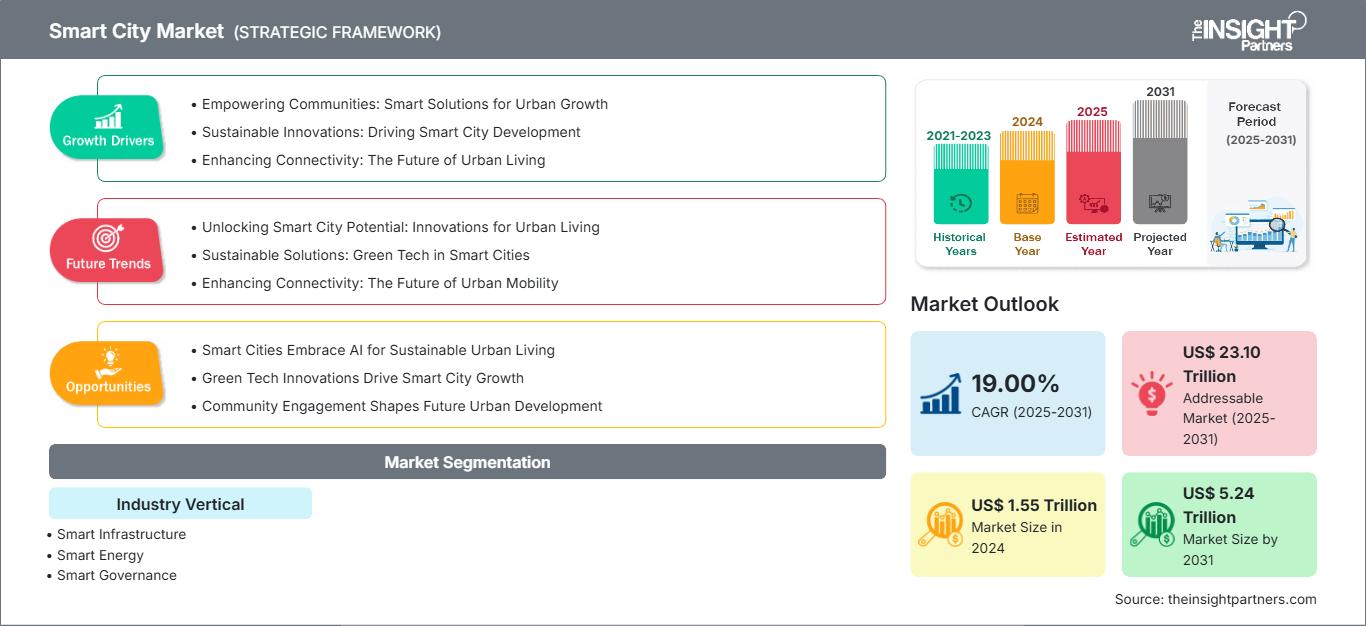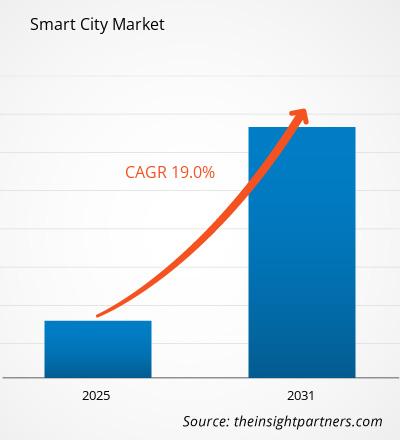스마트 시티 시장은 2022년 1조 942억 3천만 달러에서 2031년 3조 1,105억 8천만 달러로 성장할 것으로 예상되며, 2022년부터 2031년까지 연평균 성장률 19.0%로 성장할 것으로 예상됩니다.
스마트 시티는 도시 또는 지방의 다양한 측면이 첨단 기술에 기반을 둔 개념입니다. 이러한 도시는 디지털 기술과 인터넷을 활용하여 에너지 효율을 최적화하고 시민의 보안을 강화함으로써 서비스 성능과 삶의 질을 향상시킵니다. 스마트 시티 개념은 시민, 서비스 제공업체, 그리고 관리자를 효율적으로 연결하는 관리 시스템을 구축하기 위해 실시간 정보 접근을 가능하게 하는 강력한 연결성과 인프라를 구축하는 것을 목표로 합니다. 또한, 정부는 도시에 기본 인프라를 제공함으로써 주민들이 서비스의 전반적인 지속가능성과 생산성 향상에 적극적으로 참여하도록 보장합니다.
스마트 인프라 기술은 시간이 지남에 따라 크게 변화했으며, 시설 및 비상 대응 관리를 위한 빌딩 자동화, 빌딩 에너지 최적화, 주차 관리, 빌딩 내 통신 시스템 등 다양한 분야가 현재 널리 도입되고 있습니다. 또한, 유럽, 북미, 아시아 태평양 지역을 비롯한 여러 국가에서 친환경 건축 이니셔티브가 주목을 받고 있습니다. 에너지 소비 감소에 대한 관심과 환경 폐기물 확산에 대한 우려는 스마트 시티 개발의 주요 원동력입니다. 교통은 스마트 시티 시장 전망 기간 동안 또 다른 주요 분야가 될 것으로 예상됩니다.
요구 사항에 맞게 이 보고서를 사용자 정의하십시오.
이 보고서의 일부, 국가 수준 분석, Excel 데이터 팩을 포함하여 모든 보고서에 대한 사용자 정의를 무료로 받을 수 있을 뿐만 아니라 스타트업 및 대학을 위한 훌륭한 제안 및 할인을 이용할 수 있습니다
스마트 시티 마켓: 전략적 통찰력

-
이 보고서의 주요 주요 시장 동향을 확인하세요.이 무료 샘플에는 시장 동향부터 추정 및 예측에 이르기까지 데이터 분석이 포함됩니다.
에너지원 고갈과 비효율적인 자원 관리는 전 세계적으로 점차 주요 문제로 대두되고 있습니다. 이러한 문제는 전 세계적으로 스마트 에너지 솔루션에 대한 수요를 촉진하고 있습니다. 스마트 에너지 관리 시스템은 센서, 첨단 계량기, 재생 에너지원, 디지털 제어 및 분석 도구를 활용하여 에너지 분배 및 사용을 자동화, 모니터링 및 최적화합니다. 이러한 시스템은 소비자, 생산자, 공급자 등 다양한 이해관계자의 요구를 균형 있게 고려하여 전력망 운영 및 사용을 최적화합니다. 스마트 에너지 인프라에는 분산형 재생 에너지 발전, 마이크로그리드, 스마트 그리드 기술, 에너지 저장, 자동 수요 대응, 가상 발전소, 그리고 전기차 및 스마트 가전과 같은 수요 측면의 혁신 등 다양한 혁신 기술이 존재합니다. 이러한 혁신은 도시 전역에 걸쳐 확장된 지능형 에너지 장치 네트워크를 구축하여 에너지 소비 패턴을 상세히 파악함으로써 지역 사회 기반 에너지 모니터링 프로그램을 구축하고 건물의 에너지 효율을 향상시킵니다.
스마트 시티 시장 지역 분석
지역별로 볼 때, 북미는 2021년 글로벌 스마트 시티 시장에서 가장 큰 점유율을 차지했습니다. 이 지역의 모든 산업 분야에서 첨단 기술 솔루션 도입률이 높으면서 북미 스마트 시티 시장 성장에 기여하고 있습니다. 정부의 보조금, 세액 공제, 기술 개발 자금 지원 등 기술 도입 지원이 확대되면서 시장 활성화가 더욱 가속화되고 있으며, 이를 통해 지역 내 스마트 시티 시장 참여자들에게 수익성 있는 사업 기회를 제공하고 있습니다. 예를 들어, 2021년 11월, 미국 연방 정부는 스마트 시티의 과제 해결을 위해 인프라 투자 및 일자리 창출법에 따라 5억 달러의 자금을 지원한다고 발표했습니다. 또한, 이 지역 전역에 걸쳐 끊임없는 혁신과 제품 개발에 참여하는 여러 스마트 시티 시장 참여 기업들이 존재하며, 이는 북미 스마트 시티 시장을 더욱 성장시키고 있습니다.
시장 분석 - 스마트 시티 시장 산업 분야별 분석
스마트 시티 시장 규모는 산업 분야별로 스마트 인프라, 스마트 에너지, 스마트 거버넌스, 스마트 교통, 스마트 헬스케어, 스마트 교육으로 구분됩니다. 스마트 교통 부문은 예측 기간 동안 가장 높은 연평균 성장률(CAGR)을 기록할 것으로 예상됩니다. 스마트 교통은 신기술을 기반으로 구축되고 자원 절약을 통해 효율성을 극대화하도록 설계된 혁신적인 교통 및 모빌리티 인프라입니다. 클라우드 컴퓨팅, 4G, 머신러닝, 신규 프로젝트 운영과 같은 핵심 기술이 철도와 같은 스마트 교통 시스템에 더욱 보편화되어 전 세계적으로 효율적인 승객 및 화물 서비스를 제공할 것으로 예상되며, 이는 스마트 시티 생태계 내 다양한 산업 참여자들에게 풍부한 기회를 제공할 것입니다. 또한, 다양한 자본가와 투자자를 유치하여 스마트 교통 시장의 폭발적인 성장으로 이어질 것입니다.
스마트 시티 시장 지역별 통찰력
The Insight Partners의 분석가들은 예측 기간 동안 스마트 시티 시장에 영향을 미치는 지역별 동향과 요인들을 면밀히 분석했습니다. 이 섹션에서는 북미, 유럽, 아시아 태평양, 중동 및 아프리카, 그리고 중남미 지역의 스마트 시티 시장 세분화 및 지역별 분포도 살펴봅니다.
스마트 시티 시장 보고서 범위
| 보고서 속성 | 세부 |
|---|---|
| 시장 규모 2024 | US$ 1.55 Trillion |
| 시장규모별 2031 | US$ 5.24 Trillion |
| 글로벌 CAGR (2025 - 2031) | 19.00% |
| 이전 데이터 | 2021-2023 |
| 예측 기간 | 2025-2031 |
| 다루는 세그먼트 |
By 산업 분야
|
| 포함된 지역 및 국가 |
북미
|
| 시장 선도 기업 및 주요 회사 프로필 |
|
스마트 시티 시장 참여자 밀도: 비즈니스 역학에 미치는 영향 이해
스마트 시티 시장은 소비자 선호도 변화, 기술 발전, 그리고 제품 이점에 대한 인식 제고 등의 요인으로 인한 최종 사용자 수요 증가에 힘입어 빠르게 성장하고 있습니다. 수요가 증가함에 따라 기업들은 제품 및 서비스를 확장하고, 소비자 니즈를 충족하기 위한 혁신을 추진하며, 새로운 트렌드를 적극 활용하고 있으며, 이는 시장 성장을 더욱 가속화하고 있습니다.

- 을 얻으세요 스마트 시티 마켓 주요 주요 플레이어 개요
- 2021년 10월, Siemens AG는 Squills 인수를 발표했습니다. 이 인수를 통해 예약 및 티켓팅 소프트웨어와 같은 Siemens의 모빌리티 솔루션이 강화되었습니다.
- 2021년 5월, Microsoft Corporation과 Itron Inc는 고객에게 고도로 발전된 모바일 기기 관리(MDM) 서비스를 공동으로 제공하기 위한 전략적 파트너십을 체결했습니다.
스마트 시티 시장 규모는 북미, 유럽, 아시아 태평양(APAC), 중동 및 아프리카, 남미의 5개 주요 지역으로 구분됩니다. 2022년에는 북미가 상당한 매출 점유율로 시장을 주도했으며, 유럽이 그 뒤를 이었습니다. 또한 아시아 태평양 지역은 2022년부터 2031년까지 스마트 시티 시장에서 가장 높은 연평균 성장률(CAGR)을 기록할 것으로 예상됩니다.
주요 글로벌 스마트 시티 시장 참여 기업으로는 ABB Ltd, Cisco Systems, Inc., Oracle Corporation, Microsoft Corporation, IBM Corporation 등이 있습니다. 이 외에도 연구 조사에서는 Accenture, General Electric Company, Schneider Electric SE, Siemens AG, Ericsson AB를 포함한 여러 다른 기업이 분석되었습니다.
- 과거 분석(2년), 기준 연도, CAGR을 포함한 예측(7년)
- PEST 및 SWOT 분석
- 시장 규모 가치/거래량 - 글로벌, 지역, 국가
- 산업 및 경쟁 환경
- Excel 데이터세트
최근 보고서
사용 후기
구매 이유
- 정보에 기반한 의사 결정
- 시장 역학 이해
- 경쟁 분석
- 고객 인사이트
- 시장 예측
- 위험 완화
- 전략 기획
- 투자 타당성 분석
- 신흥 시장 파악
- 마케팅 전략 강화
- 운영 효율성 향상
- 규제 동향에 발맞춰 대응






















 무료 샘플 받기 - 스마트 시티 마켓
무료 샘플 받기 - 스마트 시티 마켓